
How to Care for Weeping Pine Trees: Essential Tips for Healthy Growth and Stunning Beauty
Looking to add a unique and captivating tree to your landscape? 
In this guide, we’ll walk you through the essential tips for maintaining your weeping pine tree, from proper watering and pruning techniques to protecting it from winter stress. Whether you’re new to gardening or an experienced landscaper, these expert tips will help you nurture your tree into a healthy, beautiful specimen. Keep reading to discover how to make your weeping pine trees flourish!
Table of Contents
ToggleUnderstanding Weeping Pine Trees 
Weeping Pine Trees, also known as Pinus strobus or Pinus cembra, are distinctive for their drooping, graceful branches that create a unique, cascading appearance. These trees are not only visually appealing but also relatively low-maintenance when given the right care. If you’re considering adding one of these beauties to your garden or landscape, it’s important to understand their unique characteristics and needs.
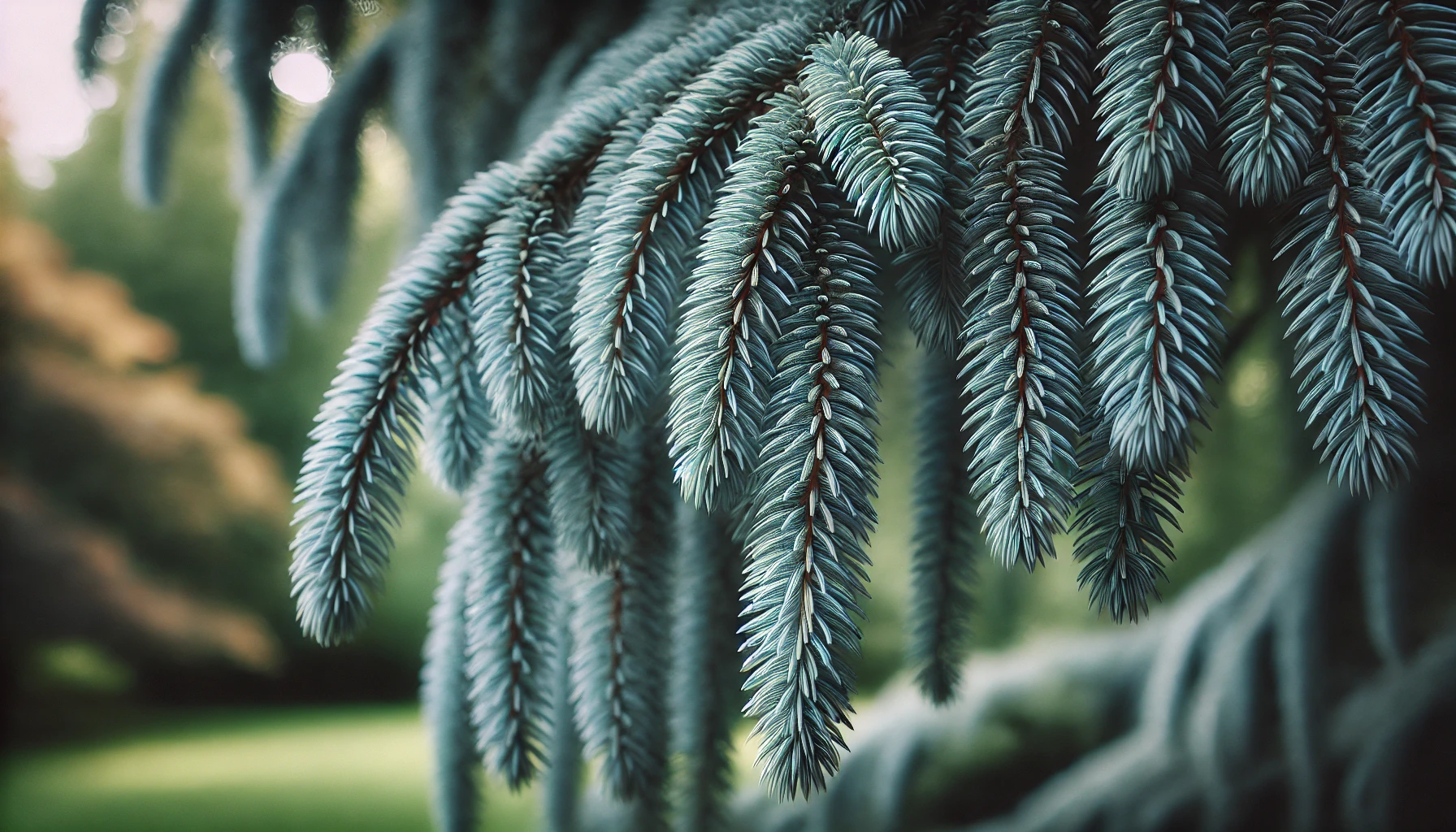
What Makes Weeping Pine Trees Special?
Weeping Pine Trees stand out due to their soft, needle-like leaves and elongated, pendulous branches that give them a dramatic, waterfall-like effect. These trees can grow up to 15 feet tall, making them perfect for smaller yards or as a striking focal point in larger landscapes. Their elegant form adds a touch of sophistication to any garden.
Key Features to Note:
- Shape & Size: Their weeping form grows downward, making them an eye-catching feature. Most varieties remain compact, but some can grow quite tall.
- Needles: Soft, blue-green or silvery needles, giving them a delicate and lush appearance.
- Pine Cones: They produce long, slender cones, adding another layer of texture to the tree.
Why Choose Weeping Pine Trees? 
- Aesthetic Appeal: Weeping Pines add a graceful, almost whimsical vibe to your outdoor space. Whether used as a statement piece or as part of a mixed border, their beauty is unmatched.
- Low Maintenance: Once established, Weeping Pines require minimal care, making them ideal for both novice gardeners and seasoned landscapers.
- Year-Round Interest: With their year-round foliage, Weeping Pines maintain their beauty through all seasons, providing evergreen structure even during the winter months.
Ideal Growing Conditions 
To ensure your Weeping Pine thrives, it’s essential to provide the right growing conditions. These trees prefer:
- Sunlight: Full sun is key to healthy growth. Aim for at least 6 hours of direct sunlight daily.
- Soil: Well-draining soil is crucial. Weeping Pines do best in slightly acidic to neutral soil.
- Water: Regular watering during dry spells, especially in the first few years after planting, helps the tree establish deep roots. However, they don’t like soggy feet, so ensure the soil drains well.
- Space: Although they are somewhat compact, make sure to plant them with enough space to accommodate their spreading branches.
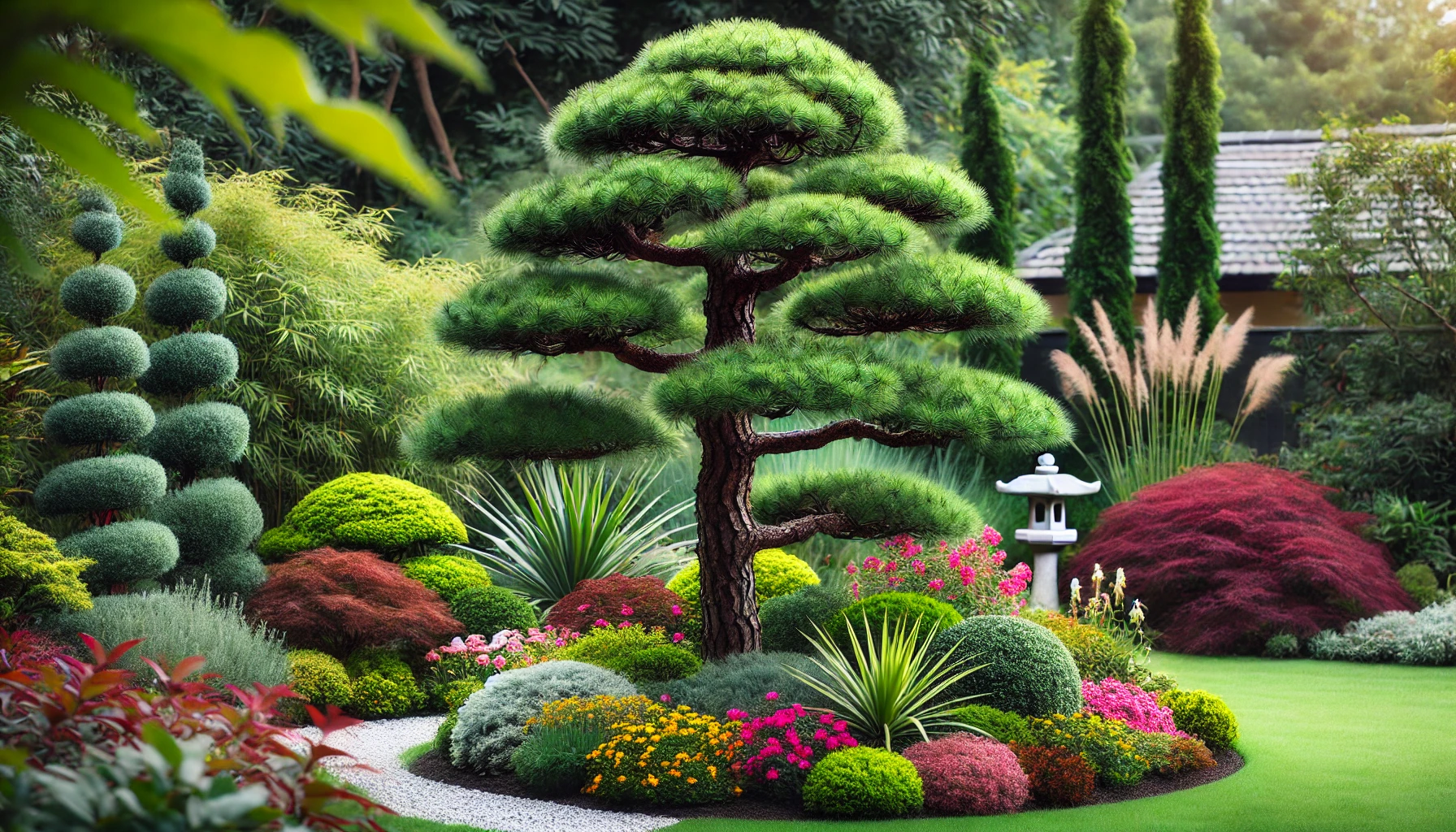
Common Issues to Watch Out For 
- Pine Needle Diseases: Watch for browning or yellowing needles. If you notice this, it may be due to fungal infections or poor drainage. Make sure the tree is not sitting in waterlogged soil.
- Pests: While generally pest-resistant, weeping pines may occasionally attract pine beetles or aphids. Regular inspection and timely action can keep these critters at bay.
- Winter Damage: In colder climates, these trees can suffer from snow or ice buildup on their branches, potentially causing breakage. Trimming dead or weak branches in early spring helps prevent damage.
By understanding the unique needs and beauty of Weeping Pine Trees, you can create a thriving garden centerpiece that brings charm and tranquility to your outdoor space.
Ideal Growing Conditions for Weeping Pine Trees 
Weeping pine trees are beautiful, low-maintenance additions to any landscape, but to thrive, they need the right growing conditions. By providing the optimal environment, you can ensure that your tree grows healthy, strong, and stunning for years to come. Here’s what you need to know:
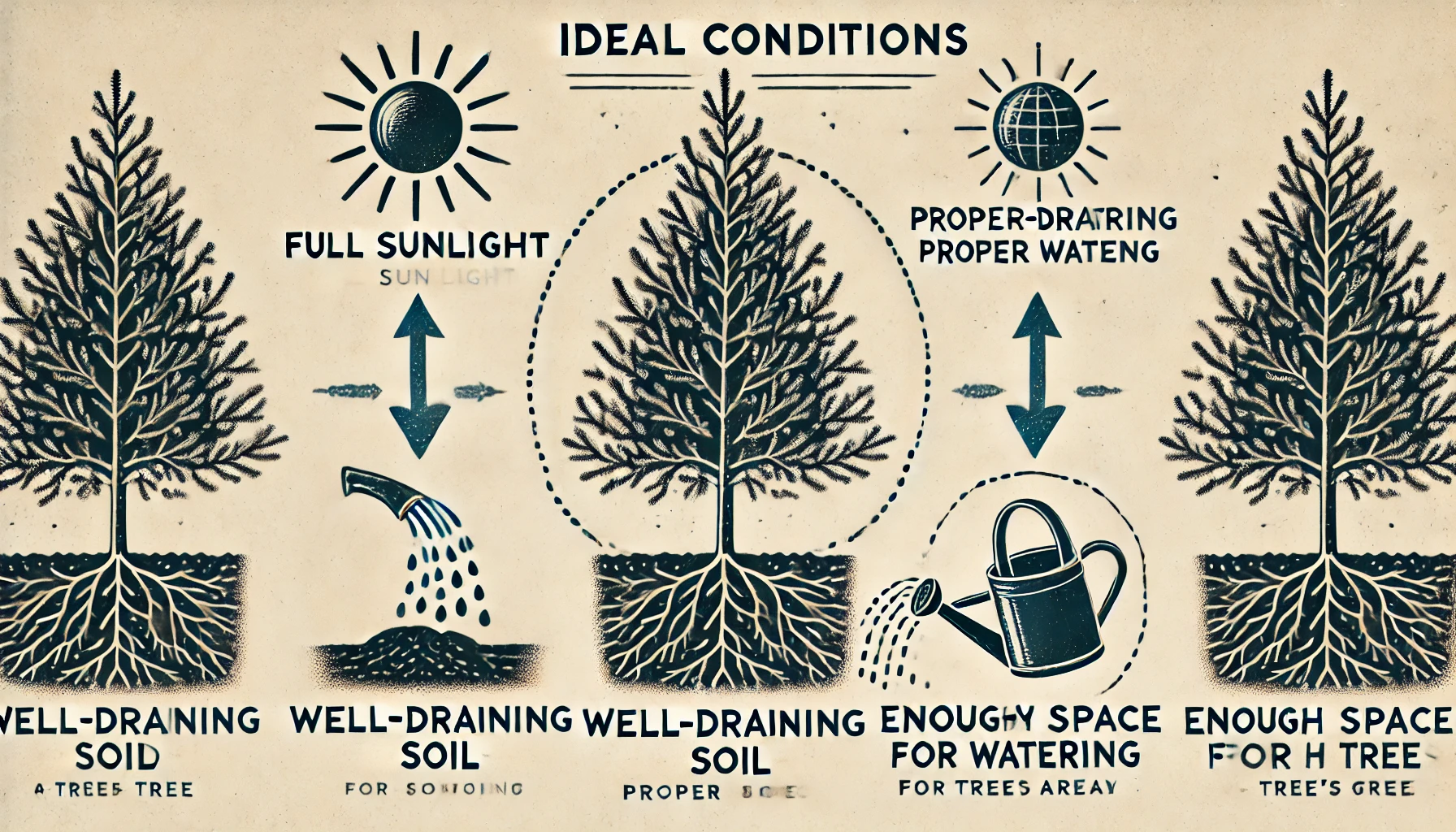
1. Sunlight Exposure 
Weeping pines love the sun! Ensure your tree gets plenty of full sunlight each day (at least 6 hours). While they can tolerate some light shade, they grow best when basking in direct sunlight. This helps them develop strong branches and a fuller shape.
2. Soil Requirements 
Well-draining soil is crucial. Weeping pines prefer slightly acidic to neutral soil (pH 6.0–7.5). If your soil is heavy in clay or tends to retain water, consider improving drainage by mixing in sand or organic matter. This prevents water from sitting around the roots, which can lead to root rot.
3. Watering Needs 
Weeping pines are drought-tolerant once established, but they still need regular watering in their first few years. Keep the soil moist (but not soggy) during the growing season, especially during dry spells. Deep watering encourages roots to grow deeper, making the tree more resilient in the long run.
4. Temperature and Climate 
These pines are hardy and can tolerate a range of temperatures, but they prefer cool to moderate climates. They can survive in zones 4 to 8, with cold winters and mild summers. Avoid planting in areas with extreme heat or harsh winters, as this can stress the tree and stunt its growth.
5. Spacing and Air Circulation 
To keep your weeping pine healthy, give it enough space to grow. Ideally, plant it in a spot with good air circulation, away from large structures or other trees. This reduces the risk of diseases and allows the tree’s branches to droop naturally, enhancing its weeping shape.
6. Protection from Strong Winds 
Weeping pines, with their drooping branches, are more vulnerable to wind damage. If you live in a windy area, consider planting your tree in a protected spot, such as near a wall or fence, to shield it from harsh winds.
By meeting these essential growing conditions, you’ll ensure your weeping pine tree thrives and becomes a beautiful, long-lasting feature in your garden or yard!
Watering and Fertilizing Weeping Pine Trees 

Caring for your Weeping Pine tree involves providing the right balance of water and nutrients. These graceful trees thrive in well-maintained environments, and proper watering and fertilizing are key to their health and beauty. Let’s break it down so you can ensure your Weeping Pine stays vibrant and strong.
Watering Your Weeping Pine 
Weeping Pines are fairly low-maintenance when it comes to watering, but getting it just right is essential. Too much or too little water can harm your tree. Here’s what you need to know:
- Watering Frequency:
- Young Trees: During the first year, water your Weeping Pine every 1-2 weeks, especially during hot, dry weather. Ensure the soil is moist but not soggy.
- Established Trees: Once your Weeping Pine is established (after 1 year), it generally needs watering only during dry spells or droughts. Water deeply every 2-3 weeks in hot weather.
- Watering Method:
- Water slowly and deeply at the base of the tree to encourage deep root growth. Avoid shallow watering, as it can lead to weak roots.
- A good rule of thumb is to water when the top 2 inches of soil feel dry to the touch.
- Water slowly and deeply at the base of the tree to encourage deep root growth. Avoid shallow watering, as it can lead to weak roots.
- Signs of Overwatering:
- Yellowing needles and root rot are common symptoms of overwatering. Be sure not to let the tree sit in waterlogged soil.
- Signs of Underwatering:
- Brown, dry needle tips or wilting branches can indicate your Weeping Pine isn’t getting enough water.

- Brown, dry needle tips or wilting branches can indicate your Weeping Pine isn’t getting enough water.
Fertilizing Your Weeping Pine 
Weeping Pines don’t require heavy feeding, but providing a boost of nutrients can support healthy growth, especially in poor or depleted soil.
- When to Fertilize:
- Spring is the best time to fertilize, just before the tree begins its active growing season. Apply a slow-release, balanced fertilizer designed for evergreens.
- Avoid fertilizing in late fall or winter when the tree is dormant.
- How Much to Fertilize:
- For young trees, use a small amount of fertilizer to avoid burning the roots. As the tree matures, you can increase the amount slightly, following the instructions on the fertilizer package.
- Avoid over-fertilizing, as this can lead to weak, leggy growth.
- Organic Fertilizers:
- Consider using organic options like compost or well-rotted manure. These provide slow, steady nourishment without the risk of fertilizer burn.
- Consider using organic options like compost or well-rotted manure. These provide slow, steady nourishment without the risk of fertilizer burn.
- Signs of Nutrient Deficiency:
- If the needles turn yellow (especially older ones), it could be a sign of nitrogen deficiency. For a phosphorus deficiency, look for dark green or purplish needles.
By paying attention to watering and fertilizing schedules, your Weeping Pine tree will grow strong, lush, and full of beauty year after year. Happy gardening!
Pruning and Shaping Weeping Pine Trees 

Pruning and shaping your weeping pine tree is key to maintaining its health, appearance, and overall growth. Whether you want to enhance its natural beauty or control its size, proper care is essential. Here’s a practical guide to help you shape and prune your weeping pine with ease.
Why Prune Weeping Pine Trees? 
Pruning serves multiple purposes:
- Remove dead or diseased branches to improve tree health.
- Encourage strong growth by allowing sunlight and air to reach the inner branches.
- Maintain the tree’s shape to keep it looking its best.
- Control size and spread, especially if you’re planting near structures or other plants.

When to Prune? 
The best time to prune your weeping pine tree is in late winter or early spring before new growth begins. This minimizes stress and helps the tree heal quickly. Avoid pruning during the growing season, as this can interfere with the tree’s natural processes.
How to Prune Weeping Pine Trees? 
- Gather the Right Tools: You’ll need a pair of sharp pruning shears, loppers, and possibly a pruning saw for thicker branches.
- Start with Dead or Damaged Wood: Begin by cutting off any dead, broken, or diseased branches. These are easy to spot because they’re dry, discolored, or lacking needles.
- Remove Crossing Branches: Look for branches that cross over each other or grow inward toward the trunk. These can cause rubbing, which leads to damage over time.
- Thin Out the Center: Weeping pines often grow densely in the center. Thin out some of the inner branches to improve air circulation and allow sunlight to reach the interior of the tree.
- Shape the Tree: If you’re shaping the tree, trim back the tips of branches to encourage a more uniform, graceful shape. Weeping pines are known for their natural, cascading form, so avoid cutting too much at once. Focus on enhancing this natural look.
- Don’t Over-Prune: It’s tempting to cut back too much, but remember, less is more. Weeping pines are slow growers, so pruning too aggressively can stunt their development.
Tips for Shaping Weeping Pine Trees 
- Aim for a graceful, cascading shape: Weeping pines naturally grow with drooping branches, so keep this in mind as you prune. Trim carefully to enhance the tree’s flowing appearance.
- Focus on the outer branches: To avoid cutting into the center too much, focus on pruning the outer branches for a fuller, well-rounded look.
- Avoid creating “lollipops”: Don’t cut the top too much or leave a thin, tall trunk with a thick canopy at the top. Aim for a more balanced structure.
Maintenance After Pruning 
Once you’ve finished pruning, keep an eye on the tree’s recovery. Make sure it gets enough water, especially in the first few weeks, and apply a light layer of mulch around the base to retain moisture.
Regularly check your weeping pine for any new growth or dead branches that need attention. By following these steps, you’ll help your tree stay healthy, attractive, and properly shaped for years to come.
Happy pruning!
Common Problems and Solutions 
Taking care of a Weeping Pine Tree can be rewarding, but like any plant, it’s not without its challenges. Below, we’ll tackle some of the most common problems you might face and provide practical solutions to keep your tree healthy and thriving.
1. Yellowing Needles 
Problem: Yellowing needles are a sign that your tree is stressed. This could be due to overwatering, poor drainage, or a nutrient deficiency.
Solution:
- Check Watering: Weeping Pines don’t like sitting in soggy soil. Make sure the soil drains well, and let it dry out between waterings.
- Fertilize Properly: Apply a balanced, slow-release fertilizer in early spring. A deficiency in nutrients like nitrogen can cause yellowing.
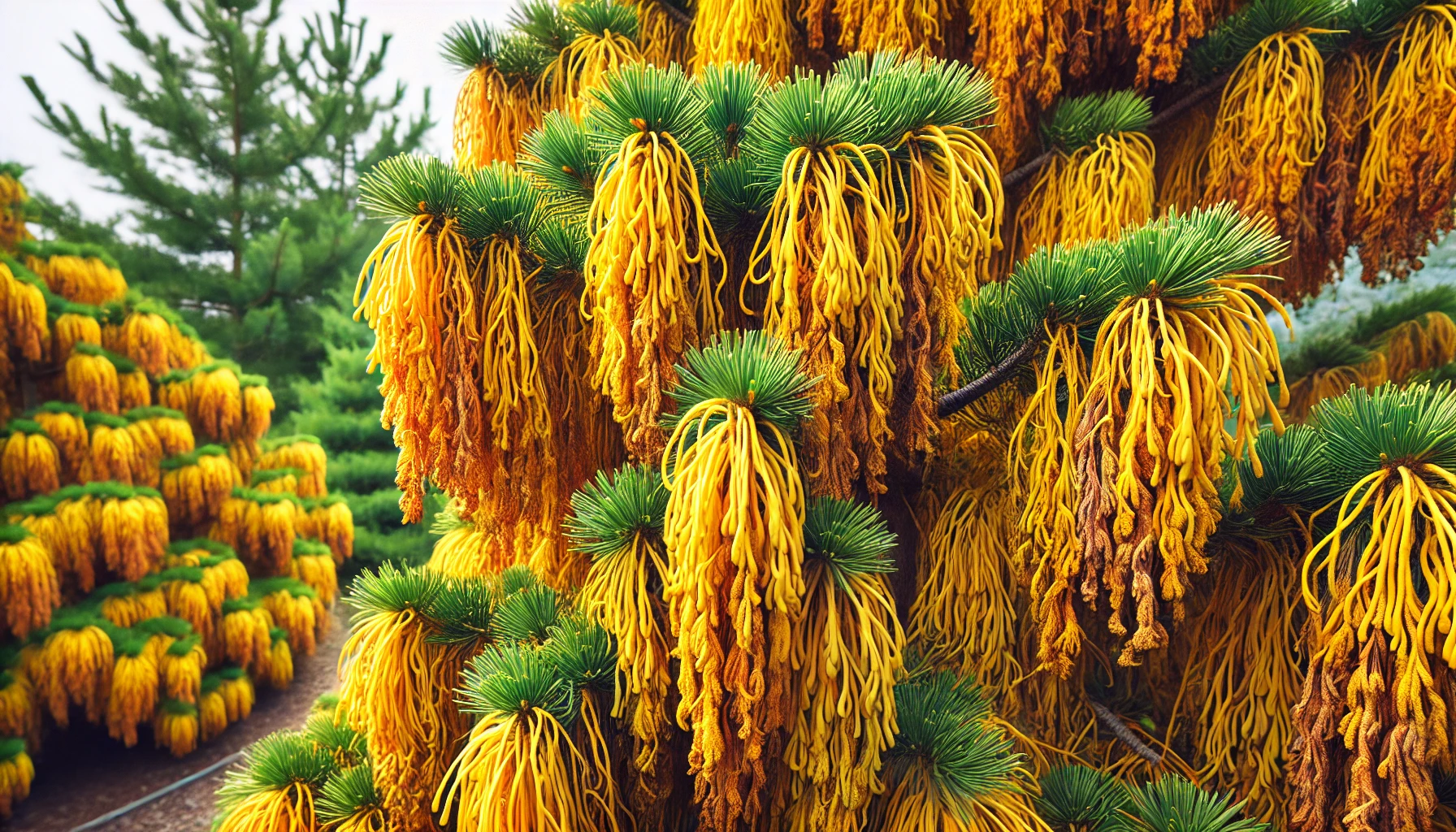
2. Brown Needle Tips 
Problem: Brown tips on your Weeping Pine’s needles are often a sign of water stress or environmental factors like drought or high temperatures.
Solution:
- Adjust Watering: Ensure the tree is getting enough water, especially in the summer months. Deep watering is better than frequent shallow watering.
- Mulch Around the Base: Apply mulch to help retain moisture and regulate temperature around the roots.
3. Pest Infestations 
Problem: Weeping Pine Trees can fall victim to pests like aphids, pine beetles, or scale insects, which damage the tree’s health.
Solution:
- Inspect Regularly: Check for signs of pests, such as sticky residue (aphid secretion) or holes in the bark (pine beetles).
- Natural Remedies: Use insecticidal soap or neem oil for minor infestations. For serious problems, consult a professional arborist.
4. Root Rot 
Problem: Root rot is a common issue caused by overwatering or poor soil drainage. The roots start to decay, which leads to overall tree decline.
Solution:
- Improve Drainage: Make sure the soil has good drainage. Consider replanting the tree in a more suitable location if necessary.
- Water Correctly: Water deeply but infrequently. Avoid watering the tree every day, and ensure the soil is allowed to dry out between waterings.
5. Weeping Pine Tree Not Growing or Stunted Growth 
Problem: Stunted growth can occur if the tree isn’t getting the nutrients it needs or if the environment isn’t ideal.
Solution:
- Check Light and Location: Weeping Pines need full sunlight to thrive. If your tree is too shaded, consider moving it to a sunnier spot.
- Fertilize and Prune: Regularly fertilize in early spring, and prune dead or diseased branches to encourage healthy growth.
6. Excessive Needle Drop 
Problem: Needle drop is natural, especially in older trees, but if you’re seeing more than usual, it could be a sign of stress or environmental changes.
Solution:
- Evaluate Environmental Stressors: Consider whether the tree has been exposed to extreme weather, drought, or recent construction work.
- Don’t Panic: A small amount of needle drop is natural, particularly in the fall. However, if the shedding is excessive, check for pest damage or poor soil conditions.
7. Wilting or Drooping Branches 
Problem: If the branches of your Weeping Pine are wilting or drooping, it could be a sign of water stress, root issues, or disease.
Solution:
- Check for Root Damage: Examine the roots for signs of rot or compaction. If the roots are damaged, you may need to prune affected areas and adjust watering practices.
- Support Branches: If the branches are too heavy with snow or rainwater, gently remove excess weight to avoid breaking. Proper pruning can also help maintain a balanced structure.
8. Discoloration or Fungal Growth 
Problem: Fungal diseases like needle blight or rust can cause discoloration or unusual growths on the needles.
Solution:
- Prune Affected Areas: Remove and dispose of any infected branches to prevent the spread of the disease.
- Apply Fungicide: Consider using a fungicide treatment if the issue persists. Always follow label instructions for best results.
By being mindful of these common problems and applying the right solutions, you can ensure your Weeping Pine Tree stays healthy, vibrant, and beautiful for years to come!
Winter Care for Weeping Pine Trees 

Weeping pine trees are resilient, but they do need some extra care during the winter months to stay healthy and continue thriving. Winter can be harsh, with freezing temperatures, snow, and ice putting stress on these beautiful trees. Here’s how to protect your weeping pine and ensure it survives the cold season with ease.
1. Mulch Around the Base 
Mulching is one of the best ways to protect your weeping pine in winter. Apply a thick layer of organic mulch (like bark, wood chips, or straw) around the base of the tree. This helps to insulate the roots, preventing them from freezing during cold spells. It also retains moisture, reducing the risk of drought in the winter months.
2. Watering Before the Freeze 
Although weeping pines are hardy, they still need water, especially before a freeze. Make sure your tree is well-watered in the late fall before the ground freezes. This will help the tree withstand winter stress and keep its roots hydrated, which is crucial when the tree can’t take up water from the ground during the winter months.
3. Shield the Tree from Salt Damage 
If you live in an area where roads are salted for snow removal, make sure to protect your weeping pine from the harmful effects of salt. Salt can damage the roots and needles of your tree. You can create a barrier around your tree with burlap or fencing to prevent the salt from coming in contact with it.
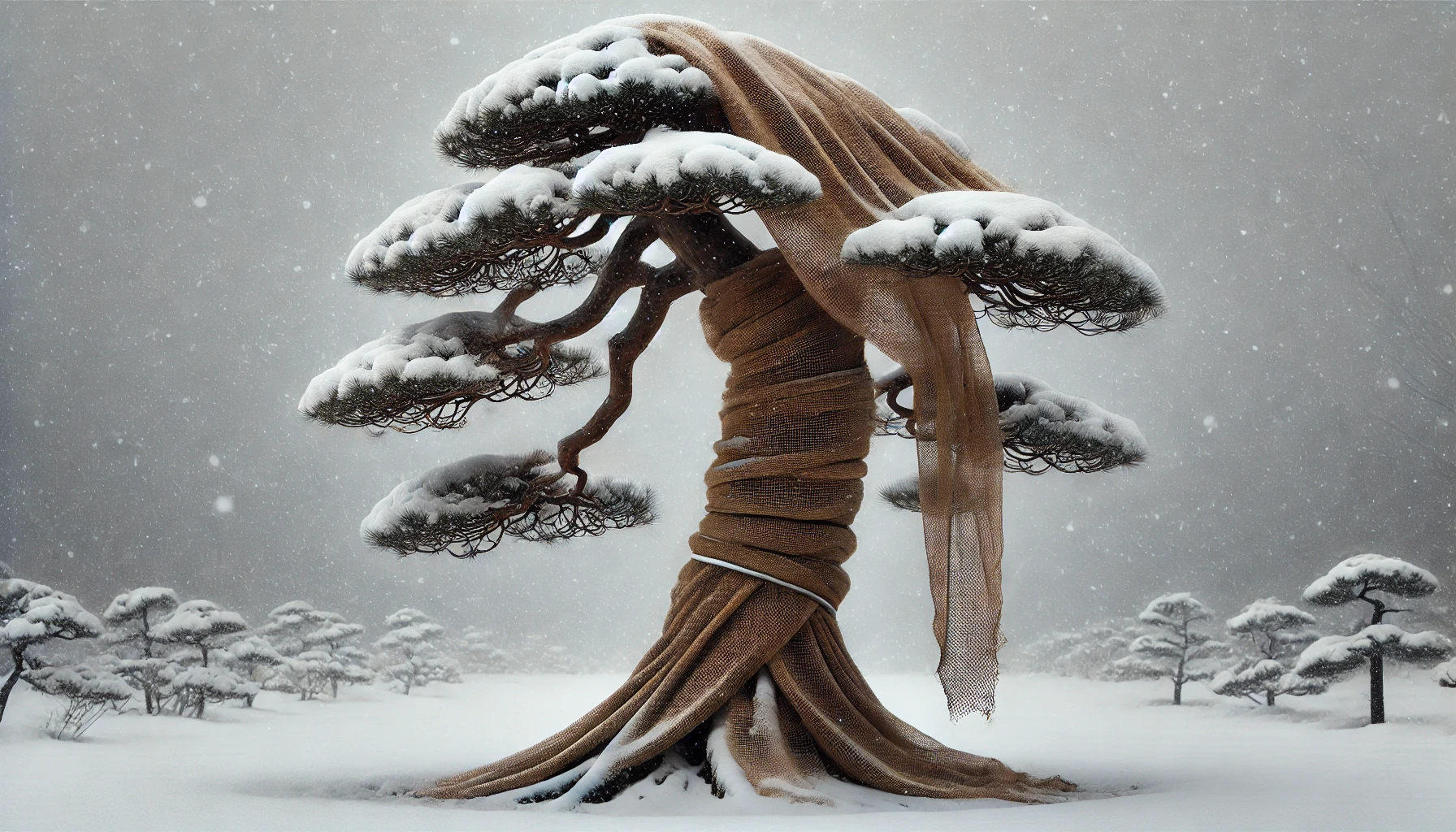
4. Prune Dead or Damaged Branches 
Winter weather can cause branches to break, especially if they are already weak or damaged. Before the snow and ice arrive, inspect your tree and prune away any dead or damaged branches. This will not only improve the tree’s appearance but also reduce the risk of broken branches under the weight of snow or ice.
5. Use Burlap or Wind Barriers 
Weeping pines are sensitive to strong winds, which can dry out their needles in the winter months. To prevent windburn, you can set up a wind barrier made of burlap or other breathable fabric. This will protect the tree from the cold, dry winds while still allowing it to breathe.
6. Avoid Over-Fertilizing in Fall 
Fertilizing your weeping pine tree too late in the season can encourage new growth that may not survive the winter. Make sure to stop fertilizing in late summer or early fall to allow the tree to go dormant for the winter. Over-fertilizing can also stress the tree, making it more vulnerable to winter damage.
7. Check for Snow and Ice Buildup 
Heavy snow or ice can damage the delicate branches of a weeping pine. After a heavy snowstorm or ice storm, gently shake the tree to remove excess snow and ice from the branches. Be cautious when doing this—don’t force branches that are frozen or brittle, as they could snap under pressure.
By taking these simple yet effective steps, you can ensure that your weeping pine tree stays strong and healthy throughout the winter. With the right care, your tree will not only survive but thrive, offering you stunning beauty year after year.
Conclusion
Caring for weeping pine trees requires some attention, but with the right approach, these stunning trees can thrive and become the centerpiece of your garden. By providing proper watering, choosing the right soil, and pruning regularly to maintain their cascading shape, you’ll ensure your tree stays healthy and beautiful year after year.

Remember, healthy weeping pine trees not only add aesthetic value but also contribute to the overall balance of your landscape. With the tips and techniques shared in this guide, you now have the tools to nurture your tree into a vibrant, graceful addition to your yard. Start caring for your weeping pine tree today, and watch it flourish into a breathtaking beauty that will last for generations to come!
Frequently Asked Questions(FAQ)
What are Weeping Pine Trees?
Weeping pine trees are a type of coniferous tree known for their unique drooping or “weeping” branches. These trees have an elegant, graceful appearance and are often used as ornamental plants in landscapes. Their branches tend to grow downward, giving them a distinctive, cascading look.
How tall do Weeping Pine Trees grow?
Weeping pine trees can vary in size depending on the species and growing conditions. Generally, they can reach heights of 6 to 20 feet (1.8 to 6 meters), but some varieties may grow taller with proper care.
Where is the best location to plant a Weeping Pine Tree?
Weeping pine trees thrive in full sun to partial shade. They prefer well-drained, slightly acidic soil and can be planted in gardens, parks, or large landscapes. Avoid areas with heavy foot traffic or other plants that may block sunlight.
Are Weeping Pine Trees resistant to pests and diseases?
Weeping pine trees are generally hardy and resistant to many common pests and diseases. However, they can occasionally suffer from issues like pine needle rust, pine beetles, or fungal infections. Regular inspection and good care practices can help prevent these issues.
Can I grow a Weeping Pine Tree in a container?
Yes, weeping pine trees can be grown in containers, making them a great choice for patios or smaller spaces. Ensure the container is large enough to allow for growth, has good drainage, and use a high-quality potting mix.
Are Weeping Pine Trees hardy in cold climates?
Yes, many weeping pine varieties are cold-hardy and can withstand freezing temperatures. However, the degree of cold tolerance can vary by species, so it’s important to choose a variety suited to your climate zone.
How fast do Weeping Pine Trees grow?
Weeping pine trees grow at a moderate pace. Typically, they can grow between 6 to 12 inches (15 to 30 cm) per year, depending on factors like soil quality, sunlight, and water availability.
Can I propagate Weeping Pine Trees?
Yes, weeping pines can be propagated through methods such as grafting or taking cuttings, though it can be more challenging than growing from seed. Grafting is the most common method for maintaining the unique weeping characteristic of the tree.



